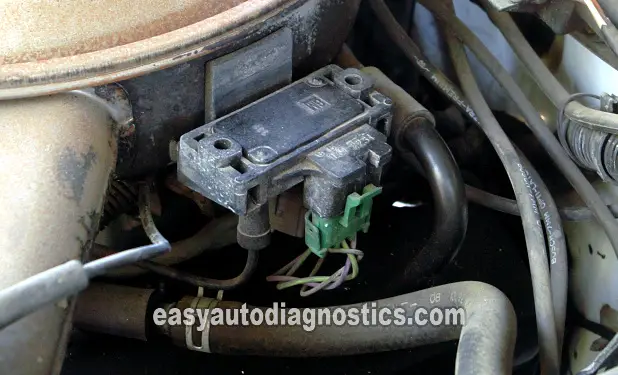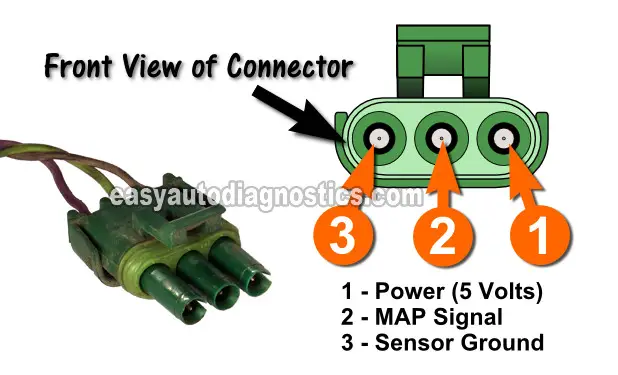
Your 2.8L Chevrolet S10 pickup (GMC S15 pickup, GMC Sonoma) has a speed-density fuel system. This means the fuel injection computer relies heavily on the MAP sensor to know how much fuel to inject into the engine.
If the MAP sensor fails, your S10 pickup (S15 pickup, Sonoma) will be in a world of pain. Fortunately, you can accurately test the manifold absolute pressure (MAP) sensor with a multimeter and vacuum pump.
This tutorial will show you how to perform the tests to either rule out the MAP as bad or eliminate it as the source of the diagnostic trouble code or drivability issue your pickup is experiencing.
Contents of this tutorial:
- Symptoms Of A Bad MAP Sensor.
- Where To Buy The MAP Sensor And Save.
- MAP Sensor Circuit Descriptions.
- TEST 1: Checking The MAP Sensor Signal.
- TEST 2: Making Sure The MAP Is Getting Power.
- TEST 3: Making Sure The MAP Is Getting Ground.
- MAP Sensor Code Won't Go Away.
- More 2.8L Chevy S10 Pickup, GMC S15 Pickup, And GMC Sonoma Tutorials.
![]() You can find this tutorial in Spanish here: Cómo Probar El Sensor MAP Con Multímetro (2.8L V6 GM) (at: autotecnico-online.com).
You can find this tutorial in Spanish here: Cómo Probar El Sensor MAP Con Multímetro (2.8L V6 GM) (at: autotecnico-online.com).
APPLIES TO: This tutorial applies to the following vehicles:
- 2.8L Chevrolet S10 Pickup: 1988, 1989, 1990, 1991, 1992, 1993.
- 2.8L GMC S15 Pickup: 1988, 1989, 1990.
- 2.8L GMC Sonoma: 1991, 1992, 1993.
This tutorial also applies to the 2.8L Chevy S10 Blazer, 2.8L GMC S15 Jimmy. See the 'Applies To' box on the left column (desktop) or at the bottom of the page (mobile device) for more info.
Symptoms Of A Bad MAP Sensor
The two most obvious symptoms of a bad MAP sensor are the check engine light shining nice and bright and the engine in your vehicle idling very rough.
These are some of the other symptoms your 2.8L Chevy S10 pickup (GMC S15 pickup, GMC Sonoma) will experience with a bad MAP sensor:
- A MAP diagnostic trouble code (DTC) stored in the computer's memory:
- 33: MAP Sensor Signal Voltage High.
- 34: MAP Sensor Signal Voltage Low.
- The engine does not start.
- The engine takes a long time to start (extended cranking time).
- Black smoke comes out of the tailpipe with the engine running.
- Bad gas mileage.
- The engine idles rough when running.
- Lack of power when accelerating the engine under load.
Where To Buy The MAP Sensor And Save
You can find the MAP sensor just about in anywhere. The best place to buy it and save a few bucks is online.
The following links will help you comparison shop for the original AC Delco (and after-market) MAP sensor:
Disclosure: As an Amazon Associate, I earn from qualifying purchases. Buying through these links helps support this site at no extra cost to you. Thanks for your support —it really means a lot!
Not sure if the MAP sensor fits your particular vehicle? Don't worry, once you get to the site they'll make sure it fits by asking you the specifics of your particular GM vehicle. If it doesn't fit, they'll find you the right MAP sensor.
MAP Sensor Circuit Descriptions

| Wire | Color | Description |
|---|---|---|
| 1 | Grey (GRY) | 5 Volts |
| 2 | Light green (LT GRN) | MAP signal |
| 3 | Purple (PPL) or Black With Red Stripe (BLK/RED) or Black With Orange Stripe (BLK/ORG) | Ground |
TEST 1: Checking The MAP Sensor Signal

As you already know, the downward movement of the engine pistons (while the engine is running) creates a vacuum. This vacuum exists only after the throttle plate, through the intake manifold and into the engine cylinders (any air pressure before the throttle plate is just ambient pressure).
The job of the MAP sensor is to measure the vacuum in the intake manifold. This vacuum measurement is converted to a DC voltage signal that can be easily tested with a multimeter in Volts DC mode.
To test the MAP sensor, we won't rely on the engine's vacuum. What we're going to do is provide our own vacuum using a vacuum pump. This will give us an extremely accurate test result.
NOTE: You don't have to use a vacuum pump to test the MAP sensor. You can use your mouth to apply vacuum to the MAP sensor (via a vacuum hose). Whether you're using a vacuum pump or your mouth, the important thing is to just see the voltage drop and then rise again (to its original value) as you apply vacuum to the sensor and release it.
OK, to get this show on the road, this is what you need to do:
- 1
Disconnect the MAP sensor from its vacuum hose.
- 2
Remove the MAP sensor from the air cleaner assembly.
- 3
Connect your vacuum pump to the MAP sensor's vacuum inlet port.
NOTE: If you had to disconnect the MAP sensor from its electrical connector to remove it, reconnect it to it now. - 4
Place your multimeter in Volts DC mode.
- 5
Connect the red multimeter probe to the wire that connects to the terminal labeled with the number 2 (in the image above).
This wire should be the light green (LT GRN) wire of the connector.
IMPORTANT: The MAP sensor must remain connected to its 3-wire connector. - 6
Connect the black multimeter test lead directly to the battery negative (-) terminal.
- 7
Turn the key ON but don't start the engine.
- 8
At this point your multimeter should register about 4.5 Volts DC.
- 9
Now, pump the vacuum pump to apply vacuum to the MAP sensor.
The multimeter should register the following voltages at the following vacuum values (they may differ a little on your specific vehicle):
1.) 0 in. Hg ...... 4.7 Volts.
2.) 5 in. Hg ...... 3.9 Volts.
3.) 10 in. Hg .... 3.0 Volts.
4.) 20 in. Hg .... 1.1 Volts.
NOTE: If you apply vacuum to the sensor using a method other than a vacuum pump, the output voltage should decrease as the sensor gets vacuum. - 10
Release the vacuum you applied to the MAP sensor. The voltage should increase.
OK, let's take a look at what your vacuum pump test results mean:
CASE 1: Your multimeter registered the indicated voltages as you applied vacuum. This means that the manifold absolute pressure (MAP) sensor is good and not the cause of the MAP sensor code or problem on your 2.8L Chevy S10 (GMC S15). No further testing is required.
Now, if your vehicle still has the MAP sensor code lighting up the check engine on your instrument cluster, take a look at the section: MAP Code Won't Go Away for more info.
CASE 2: Your multimeter registered voltage, but it did not increase or decrease as you applied vacuum. This confirms that the manifold absolute pressure (MAP) sensor on your S10/S15 is bad. Replacing the MAP sensor will solve the MAP code issue (33, 34).
CASE 3: Your multimeter registered 0 Volts. This usually means that the MAP sensor is fried. To be absolutely sure, I suggest confirming that the MAP sensor has power and Ground. If both (power and Ground) are present, the MAP sensor is bad. To test for power, go to: TEST 2: Making Sure The MAP Is Getting Power.




